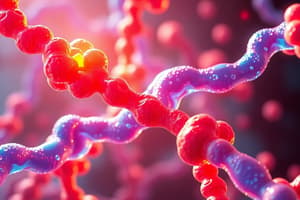Podcast
Questions and Answers
What is an active site?
What is an active site?
The active site of an enzyme is the small region where the substrate(s) binds and participates in the catalysis.
Which of the following features characterize the active site? (Select all that apply)
Which of the following features characterize the active site? (Select all that apply)
- It consists of amino acids known as catalytic residues. (correct)
- It is a small region within a large enzyme molecule. (correct)
- It is rigid in structure.
- It has a fixed shape.
Enzymes are specific in their function due to the existence of active sites.
Enzymes are specific in their function due to the existence of active sites.
True (A)
The substrate binds the enzyme (E) at the active site to form an ______ complex.
The substrate binds the enzyme (E) at the active site to form an ______ complex.
What types of bonds do substrates use to bind at the active site?
What types of bonds do substrates use to bind at the active site?
Flashcards are hidden until you start studying
Study Notes
Active Site of Enzymes
- The active site is a small region where substrates bind to the enzyme and catalysis occurs.
- The active site is formed by the enzyme's tertiary structure, creating a three-dimensional conformation.
- Catalytic residues are amino acids that are spatially arranged, not sequential, contributing to the active site's functionality.
- Active sites can be described as clefts, crevices, or pockets within larger enzyme molecules.
- They are flexible structures, adapting in shape as needed during the catalytic process.
- Each active site includes both a substrate binding site and a catalytic site, facilitating the specific biochemical reaction.
- Coenzymes or cofactors may be essential components of the catalytic site, assisting enzyme function.
- Binding at the active site occurs via weak, non-covalent interactions, allowing for substrate specificity and regulation.
- The unique arrangement of amino acids at active sites leads to enzyme specificity; commonly involved amino acids include serine, aspartate, histidine, cysteine, lysine, arginine, glutamate, and tyrosine, with serine being the most prevalent.
- Substrate binding to the enzyme (E) creates an enzyme-substrate complex (ES), leading to product formation (P) and enzyme reuse.
Studying That Suits You
Use AI to generate personalized quizzes and flashcards to suit your learning preferences.




